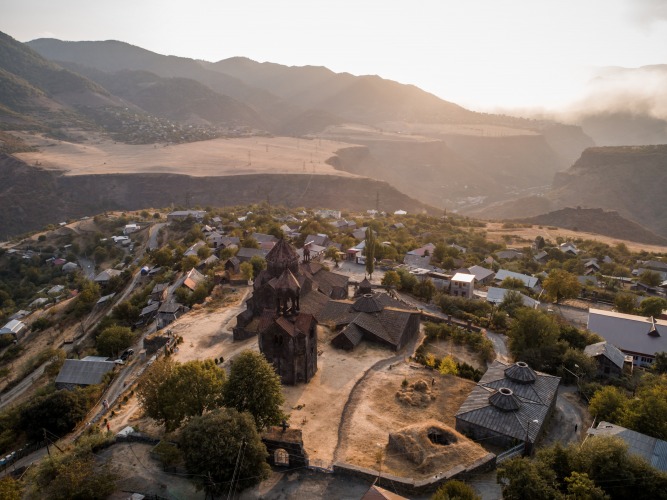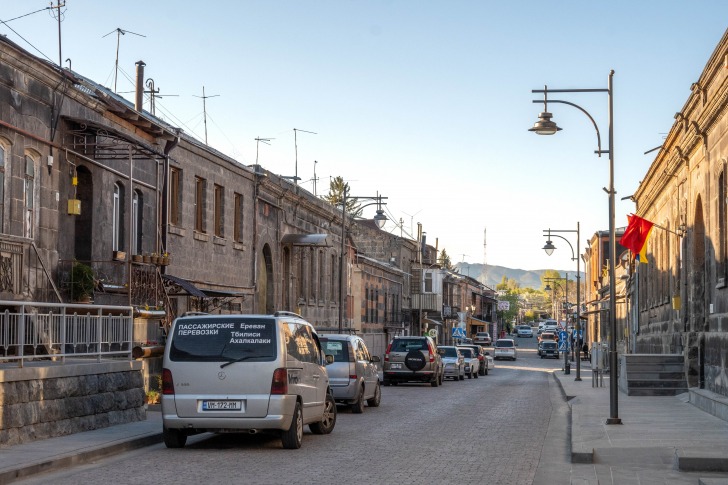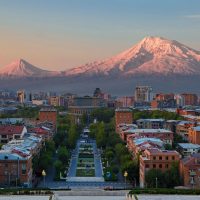The state of Armenia is located in the Caucasus region.
This region is part of three countries that make up Transcaucasia.
The other two states are Azerbaijan and Georgia.
If you are interested in moving to Armenia, there are a few areas you want to cover, such as language and currency.
But beyond that, these pros and cons will help you decide if Armenia is the right state for your next residency.

Contents [show]
Pros of Living in Armenia
1. Mediterranean Climate
For those who love the warm, airy weather of the Mediterranean, consider a move to Armenia.
The weather is great along the northern coast of the Black Sea.
Spend your summers sunbaking along the shores and indulging in the local seafood.
You may end up in the best shape of your life as a result, if the so-called Mediterranean diet is as healthy as experts claim.
2. Dig the Snow
If you are a snowbird at heart, don’t fear, as this Mediterranean-bordered state also has plenty of frozen stuff.
Stay cool and keep tubing and sledding with the four to five months of snow that falls in the southern highlands region.
Balance your lifestyle of outdoor recreation with the Black Sea and the Mediterranean sunshine with the snowy weather of the south.
The Alaska Tsaghkadzor Ski Resort is one of the state’s more luxurious places to go skiing, but there are several more in Armenia.
3. Saltworts and Wormwood
These are a few of the most interesting plant species that grow for only a sporadic period of time in the Armenian countryside.
Saltworts are seagrasses that grow in salt water, while wormwood is the ingredient used to make the green liquor drink called absinthe.
Hornbeam, Nordmann fir, and lava plateaus are also on the horizon in Armenia.
If you want some new flora to dig up, this is the state and locale to do it.
All of these exciting and ethereal species of plants that only last for a fleeting moment are growing somewhere in a season in Armenia.
4. Exciting Animal Species
In the wilds of Armenia, there are a substantial number of exotic animal species that you will never find living in the US.
The Persian gazelle; long-eared hedgehogs; mouflon, which are small feral sheep; and the Armenian viper are among the interesting animals in Armenia.
There are also goats and pheasants, which, while they are found in North America, are few and far between.
If you love animals, then you are going to really appreciate the fauna species of Armenia.
5. Roots in Ancient Mesopotamia
Armenia is one of the oldest states developed in the world with roots in Ancient Mesopotamia.
In addition, Armenia was one of the first territories to start working with bronze as a metal.
This was a major upgrade for weaponry and farming implements, which helped this society advance more rapidly and stay alive for a long.
As a result, the history of Armenia is super rich and deep.
Moving to Armenia is a great idea for any historian or history buff who is ready for an adventure.
6. Small Population Size
There are approximately 2.8 million people living in Armenia as of 2021 states the World Bank.
Compare this to the US where there were nearly 332 million people in that same year.
That’s quite a jump in population size if you are from the US.
You get a chance to meet a much higher percentage of the total social demographic when living in Armenia.
In addition, the smaller population size means you will have far fewer people on the roads and in the housing market.
As for the job sector, fewer people means a lack of opportunities simply based on supply and demand.
7. They Drink Alcohol
If you are a drinker of beer, wine, or spirited liquor, there is a chance you will get drunk when in Armenia.
There are no laws prohibiting drinking in public, and bars are openly serving the state’s most popular beer–Kilikia.
Armenia is also one of the world’s oldest wine-producing regions.
Vayots Dzor in Armenia is more than 6,000 years old and claims, according to Wine Magazine, to be the oldest winery on the planet.
Bring back bottles of vintage wine from Armenia as you visit friends from your new home abroad.
You might even luck up and start your own winery or vineyard. Watch out, Napa Valley!
8. It’s Cheaper to Live in Armenia Than in the US
It is 43 percent cheaper to live in Armenia based on the cost of living for that state and the US.
The cost of living includes how much money is required to cover basic essentials, such as food, housing, and transportation.
For example, in reference to the cost of housing, Armenians pay about 50 percent of what Americans pay for housing.
If you can spend half of what you earn in Armenia, while still working for yourself or as a contractor through a US company, you will save quite a lot of money this way.

Cons of Living in Armenia
1. One Percent Uses Renewable Energy
Unfortunately, there are not a lot of solar power or solar panel stores in Armenia, based on the demographics.
Less than one percent, at only 0.1 percent, use renewable electricity.
This means there are no solar grids or carbon footprint programs to help you reduce your own energy costs.
If you are an eco-warrior or interested in going off the grid, you will likely struggle a lot with a lack of infrastructure.
Your electricity provider most likely won’t have access to supplies to help you reduce your energy costs either.
Fortunately, the low cost of living means you will have less to pay for these utilities.
And, 100 percent of the country has electricity, so you can be free of worrying that you will not be able to power up your television and computer.
2. They Love Meats
Are you a vegetarian or a vegan?
Well, strike Armenia off the list because they love meat in this state.
Minced meat, kabobs, roasted and fried, and all kinds of pork, beef, poultry, and fish are on the menu.
Prepare to savor a lot of salty, succulent meaty bits while in Armenia.
Of course, you will be able to eat plenty of dolmas, which are stuffed grape leaves.
3. Unrest at Armenia-Azerbaijan Border
The Armenia-Azerbaijan border is currently not open for travel, according to the US Department of State.
This is due to armed conflict at the border, which also negatively affects Nagorno-Karabakh.
When traveling in Armenia, it is dangerous to go to certain regions.
That can be scary to consider as a new resident as you do not want to travel into treacherous territories.
4. They Don’t Take Plastic
As in credit cards–Armenians do not accept credit cards for most shop purchases.
Therefore, you will either have to use an in-state card or the ATM to withdraw cash as Armenian dram.
If you are an American who uses a credit card a lot for expenses, such as for business spending or traveling, forget about it in Armenia.
5. High Poverty Rate
While the cost of living in Armenia is very low compared to the US, so is the amount of money earned gross per capita, averaging $4,000 USD per adult annually.
The poverty rate in Armenia is 26 percent, which is nearly three times higher than that of the US.
This can be concerning if you are wealthy, or particularly poor, and hope to move to a country that will improve your earnings potential.
In that case, forget about Armenia.
6. Lack of People
As noted, there are fewer than 3 million people in the entire state of Armenia.
You could practically meet someone from every family tree if you work in a public job in this part of the world.
If you are big on meeting new people all of the time, Armenia will make your social world feel very small.
You may even feel claustrophobic at the lack of people who live in this state.
7. Domestic Violence is a Major Problem
Unfortunately, with the smaller population size, domestic violence is rampant.
This could be associated with more tight-knit community bonds that help protect the perpetrator rather than the victim.
Either way, the Human Rights Watch World Report 2021 states that in the first half of that year, 326 counts of domestic violence were reported.
For individuals who are worried about a loved one who is marrying someone in Armenia and moving abroad, there is reason to feel concerned.
8. Land Mines Kill
Then there are the land mines, and the last thing anyone in Armenia wants to do is step on one of those.
Unfortunately, as a result of civil unrest on the northern border with Azerbaijan, more than 100 people were killed by landmines, according to Amnesty International.
Watching where you walk is only going to get you so far in the case of a hidden bomb in the sand.
Pros and Cons of Living in Armenia – Summary Table
| Pros of Living in Armenia | Cons of Living in Armenia |
|---|---|
| 1. Mediterranean Climate | 1. One Percent Uses Renewable Energy |
| 2. Dig the Snow | 2. They Love Meats |
| 3. Saltworts and Wormwood | 3. Unrest at Armenia-Azerbaijan Border |
| 4. Exciting Animal Species | 4. They Don’t Take Plastic |
| 5. Roots in Ancient Mesopotamia | 5. High Poverty Rate |
| 6. Small Population Size | 6. Lack of People |
| 7. They Drink Alcohol | 7. Domestic Violence is a Major Problem |
| 8. It’s Cheaper to Live in Armenia Than in the US | 8. Land Mines Kill |
Armenia Safety Overview
READ THE FULL REPORT: Armenia Safety Review
Safety Index:
- OVERALL RISK: LOW
- TRANSPORT & TAXIS RISK: MEDIUM
- PICKPOCKETS RISK: MEDIUM
- NATURAL DISASTERS RISK: MEDIUM
- MUGGING RISK: LOW
- TERRORISM RISK: LOW
- SCAMS RISK: MEDIUM
- WOMEN TRAVELERS RISK: LOW
Frequently Asked Questions
When did Armenia become independent?
In 1991, with the overthrow of the Soviet Union, the three Transcaucasia states including Armenia were granted their independence.
What is the language spoken by most Armenians?
The official language of Armenia is Armenian.
The way to say “hello” in Armenian is written as Բարեւ Ձեզ and pronounced as Barev DZez.
You can also simply say “hi” via Barev.
What is the currency of Armenia?
In Armenia, the Armenian dram is the official currency.
Another nearby state that also uses the dram for its currency is the Republic of Artsakh.
Is Armenia a third-world country like Ethiopia?
No, Armenia is a second-world country that is in between third-world Ethiopia and first-world Canada.
The main reason that Armenia is a second and not first-world country is that the state has not joined NATO or the Communist bloc for politics.
However, 34 percent of national parliament seats are currently held, and Armenians hold political elections regularly.
In addition, 69 percent of the population has safe sanitation and 100 percent have electricity.
These indications show that Armenia is well advanced in most areas and considered a second-world country.
Can foreigners buy a house in Armenia?
Yes, in Armenia, anyone who lives there, regardless of their country of origin, can buy a house.
They are also able to purchase land and have ownership rights just like a natural-born Armenian.











